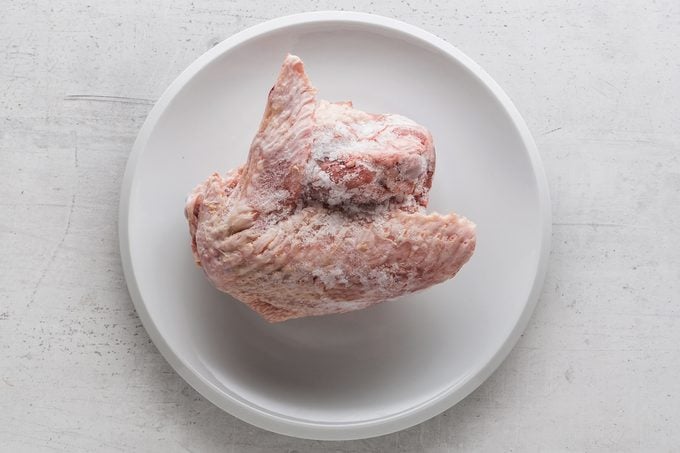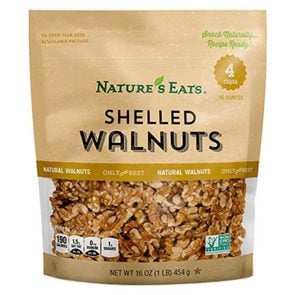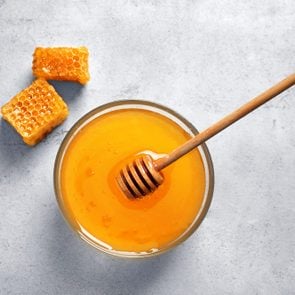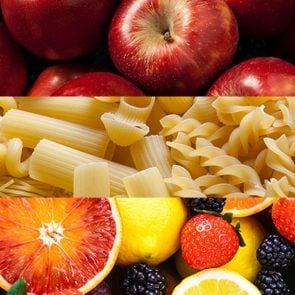Can You Eat Freezer Burned Food? 5 Things to Know
Updated: Aug. 30, 2021
Freezer burn might not look that serious—what's a little ice?—but it can leave a bad aftertaste. Here's what experts want you to know about eating it.
Frozen food basics
The scene: You’re digging through your freezer for the last Trader Joe’s cauliflower gnocchi. You find one buried in the back, but open it up to find freezer burn.
Does this icy covering mean you need to order takeout instead? Not necessarily.
Experts reveal what causes freezer burn, what it does to your food, and what you can do to avoid it, too.
What is freezer burn?
Freezer burn isn’t related to heat, fire, or any type of “burning” at all.
It’s actually a result of excessive airflow or inadequate packaging that causes dehydration or drying on the surface of food, says Karen M. Schaich, PhD, a food science professor at Rutgers University.
“Water evaporates from frozen food over time and then forms ice crystals on the surface of the food,” explains registered dietitian nutritionist Malina Malkani.
What does freezer burn look like?
Freezer burn looks like a whitish scale or leathery crust on the surface of the frozen food. And it may have a stale off-odor or flavor, too.
Schaich says that freezer burn also causes color fading, and may make the texture of the food surface a bit tougher.
“How much of any of these occur depends on the extent of drying and the types of materials,” she says.
The longer that food like chicken is kept in the freezer, the more likely it will get freezer burn, according to the Journal of Food Science.
Is freezer burn bad?
Freezer burn may hurt the taste or texture of food, but Schaich notes that it does not form toxins or cause tons of nutrient loss.
“This is a phenomenon that occurs in relatively thin layers on the surface of foods and does not permeate through,” she says.
And freezer burn is also common if you are guilty of repeatedly refreezing and defrosting foods.
“During each cycle, water is released from cells in natural materials or from binding to macromolecules such as proteins and starches in prepared foods, accelerating dehydration,” Schaich says.
This released water will migrate to the surface of the food and collect there as an ice layer accelerating the development of off-flavors and odors.
(Here are the fruits and vegetables you should buy frozen.)

Can you eat freezer burned food?
Yes. The bottom line is that freezer burn by itself does not make food unsafe to eat, according to Malkani.
Safety comes into play if the food is stored improperly before, during, or after freezing, Malkani says.
“If meats, for example, are frozen past their ‘freeze by’ date on the package, or they are thawed on the counter or in the sink, pathogenic organisms, which are usually not destroyed in the freezer, can have an opportunity to grow and cause food-borne illness, even after the food is cooked,” Malkani says.
So make sure your food is fresh when you put it in the freezer, and thaw it correctly. You’ll also want to keep your freezer set to 0 degrees Fahrenheit, which is what the U.S. Department of Agriculture recommends.
“Food with freezer burn is safe unless repeated thawing and refreezing has allowed microbial spoilage, but that will be noticeable in other ways,” Schaich adds.
Still, freezer burn causes texture and flavor changes that many people consider unpalatable. The study in the Journal of Food Science on chicken found that the meat was 31 percent tougher after freezing than fresh.
Moderate or light dehydration may have no noticeable impact on food quality after cooking, Schaich notes. And starchy foods like breads or rolls might develop more extensive off-flavors because they often are stale after moisture removal.
For example, Schaich says she recently took shrimp and English muffins out of deep freezer storage. Both had the appearance of freezer burn on the surface and some mild odors after thawing.
“However, both were normal after cooking for scampi and cocktail (shrimp) or toasting (muffins),” she says.
“On the other hand, freezer-burned chicken may have strong off-flavors after cooking because the unsaturated lipids present oxidize.”
During freezing, it’s best to avoid freezing too many items at one time. And again, ensure the freezer is set at 0 degrees Fahrenheit or lower.
How to avoid freezer burn
The best way to avoid freezer burn is to package your frozen food in sealed containers with as little extra air as possible, Malkani recommends.
Schaich says the best method is vacuum packaging in heavy impermeable plastic.
“If [a] vacuum is not available, use multiple packaging layers of thick plastic,” she says.
“Food storage bags marked for freezer use are thicker than sandwich bags and regular food storage bags, so you could place the food in one freezer bag and then place this in a second bag the same size or larger.”
Always make sure the bags seal tightly.
Another tip: Many food manufacturers and stores package their food, especially red meats, in containers that allow air to penetrate. Therefore, it’s best to repack food into airtight containers before placing them in the freezer, according to Malkani.
She also suggests consuming the food within three months of freezing.
To keep your food quality high, Schaich says to avoid repeated defrosting and refreezing.
Foods with a naturally high water content are more likely to develop freezer burn. So pay special attention to storing things like produce, meat, and ice cream.
(This is how to freeze fresh foods.)
The bottom line
Freezer burn is an indicator, but not a guarantee, that quality may be off.
“Food is too expensive to waste, so do not automatically discard any food that has freezer burn unless the off-odors are quite rank or other changes are pronounced,” Schaich says.
And with minor flavor changes, you can always use the food in a mixture such as soup, stew, or casserole where spices and other component flavors are dominant, Schaich suggests.
Next, check out the frozen foods to avoid buying.



 11 Food Storage Tips" width="295" height="295" />
11 Food Storage Tips" width="295" height="295" />